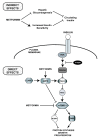Understanding the benefit of metformin use in cancer treatment
- PMID: 21470407
- PMCID: PMC3224599
- DOI: 10.1186/1741-7015-9-33
Understanding the benefit of metformin use in cancer treatment
Abstract
Biguanides have been developed for the treatment of hyperglycemia and type 2 diabetes. Recently, metformin, the most widely prescribed biguanide, has emerged as a potential anticancer agent. Epidemiological, preclinical and clinical evidence supports the use of metformin as a cancer therapeutic. The ability of metformin to lower circulating insulin may be particularly important for the treatment of cancers known to be associated with hyperinsulinemia, such as those of the breast and colon. Moreover, metformin may exhibit direct inhibitory effects on cancer cells by inhibiting mammalian target of rapamycin (mTOR) signaling and protein synthesis. The evidence supporting a role for metformin in cancer therapy and its potential molecular mechanisms of action are discussed.
Figures

References
-
- Hadden DR. Goat's rue - French lilac - Italian fitch - Spanish sainfoin: gallega officinalis and metformin: the Edinburgh connection. J R Coll Physicians Edinb. 2005;35:258–260. - PubMed
-
- Bailey CJ, Day C. Metformin: its botanical background. Pract Diab Int. 2004;21:115–117. doi: 10.1002/pdi.606. - DOI
Publication types
MeSH terms
Substances
Grants and funding
LinkOut - more resources
Full Text Sources
Other Literature Sources
Medical
Miscellaneous

